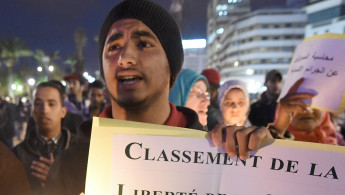Four years after Morocco protests, activists eye the longer-term
Activists believe that, although Morocco's 20 February movement four years ago didn't result in a radical transformation of politics in the kingdom, it did change the culture of political participation and protest.
The February 20 movement, which was inspired by the Arab Spring, had a great deal of momentum when it started in 2011. Thousands of protesters came out on the streets from all social, political and ideological backgrounds, from leftists to Islamists, to demand radical political and constitutional reforms.
However, the momentum quickly dissipated, and the movement's demands were watered down, especially after the Justice and Charity group withdrew from the movement. The group were the largest bloc inside the movement other than the leftists, and their defection dramatically reduced the power of the protests.
The movement that rocked Morocco, but couldn't change it. Read more. |
Morocco's 20 February movement encouraged thousands of Moroccans to come out into the streets day after day to demand political reform. The monarchy was compelled to call for the drafting of a new constitution giving broad powers to the government. The protests also forced early elections, which the Islamist Justice and Development Party won, taking the post of prime minister for the first time in the kingdom's history.
An appraisal of the 20 February movement
| The most important gain of the 20 February movement was removing the taboo on peaceful protests. - Siam Houri. |
On the occasion of the movement's fourth anniversary, the movement's youth have published their evaluation of the movement's history from the time of its strength through its decline, to "preserve the collective memory of the Moroccans".
The booklet is titled "Four years after the movement: Paths and outcomes". The writers say in their booklet that the 20 February Movement was an symbol of struggle, which belongs to all the people of Morocco. The movement is also a beacon of liberation, democracy, and fighting tyranny.
According to the writers, the 20 February movement was a natural product of the Moroccan people's struggle for freedom and against corruption and tyranny, in a regional context that saw the emergence of revolutionary movements across the Arab world.
Siam Houry, an activist in the movement, wrote "The most important gain of the 20 February movement was removing the taboo on peaceful protests and stoking the spirit of positive citizenship yearning for change, and the ability of the public opinion to influence power and decision-making."
For her part, the activist Wada Melhaf wrote in an article in the booklet that "The decline of the 20 February movement was because of three main reasons: The state's success in circumventing the demands of the movement through the constitution and the elections; the success of the Justice and Development Party; and the deterioration of revolutions in countries of the region into bloody conflicts."
Assessing the 20 February movement, political science scholar Abdul-Rahim al-Allam told al-Araby al-Jadeed, "the 20 February movement was not just a social movement with structures and branches throughout Morocco. It was and still is a dynamic social, cultural, and political movement."
Allam continued "What happened on 20 February did not come out of nowhere or without historical and regional precursors. It is a movement with roots in Moroccan history... linked to the regional and international political reality."
He continued "The idea was born out of the demands of the National Movement, which are fundamentally based on the demand for a constitution democratic in both form and content. It is also a contemporary movement that interacted with technological advancement in the world."
The articulation of a domestic agenda
| The 20 February movement could not sustain its initial high momentum. - Abdul Rahim al-Allam. |
The political scientist said that what the 20 February movement did was to locate the movement's demands as something domestic, not imposed as part of some foreign agenda. It broke the barrier of fear that all the state's ideological arms sought to build - in schools, the media, the mosques, and even within families.
"Despite the decline of the February 20 movement as a result of both local and external factors, the dynamism of broad sectors of the Moroccan people that extend more than fifty years back in history endures and remains active, and cannot be declared dead," he said.
Allam stressed that what happened on February 20, 2011 was not the end of demands to combat corruption and authoritarianism. He argued that anyone who knows the history and evolution of social movements would realise the 20 February movement must be understood in the context of its time and circumstances.
Allam expanded on this further, saying "It was to be expected that the 20 February movement could not sustain its initial high momentum, being but one stop of many throughout history in the direction of progress."
He added that "Indeed, a long history of corruption and tyranny cannot be eliminated by knockout blow in one go."
Allah concluded by saying "History has taught us that everything that happens sows the seeds of something better." He stressed the fact that the idea behind the 20 February movement was still alive in the hearts and minds of many people, and will be, as long as the circumstances that led to it persist.





 Follow the Middle East's top stories in English at The New Arab on Google News
Follow the Middle East's top stories in English at The New Arab on Google News


